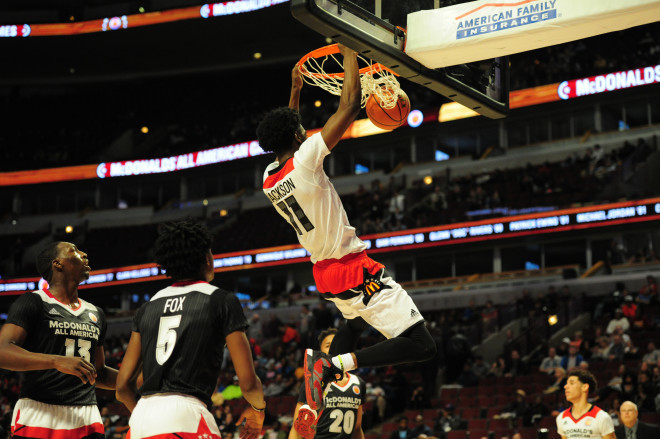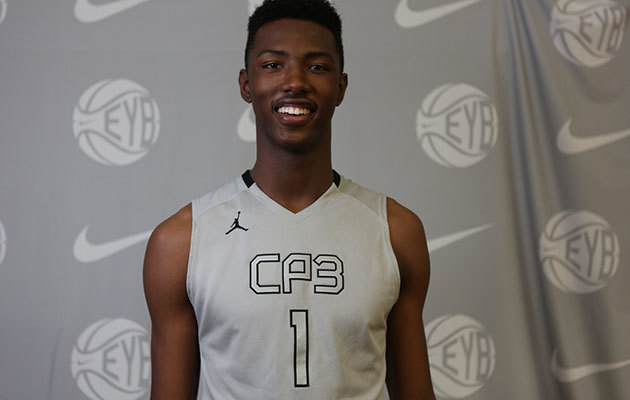Starting Five: Previewing the final 2016 rankings

The final class of 2016 rankings are just around the corner. Today, we take a look at some of the thoughts and decisions that went into the final ranking.
1. Can anybody break the top 3?
We began ranking the class of 2016 in the Fall of 2013, and ever since wing Josh Jackson, power forward Harry Giles and wing Jayson Tatum have held steady as the top three. For a short time during their junior years, Giles was able to wrestle the top spot away from Jackson, but Jackson earned it back and holds the current No. 1 spot.
Those three have clearly established themselves in the class, so the question is whether or not anybody can penetrate that top three. UCLA-bound point guard Lonzo Ball, Washington-bound combo guard Markelle Fultz and Kentucky-bound point guard De’Aaron Fox have certainly made their cases.
2. Class of 2016's strength is its depth
When the class of 2016 started breaking onto the scene in the summer of 2013, it was pretty clear there was a strong chance that the group could end up being a special one. So far, this group of seniors has fulfilled the promise they showed as freshmen.
It isn’t necessarily one or two superstars that make 2016 such a strong class, it’s the overall depth. Before these guys are done with their NBA playing careers, there are surely going to be some All-Star game appearances, but the class doesn’t look like it will produce an A-list superstar like LeBron James or Kevin Durant.
However, if the class of 2016 develops as they have over the last three or four years, it’s not going to be a surprise to see an unusually large number of players eventually find their way onto NBA rosters. On the college level, this class will have a significant impact for the next four years and is likely to produce several All-Americans and conference players of the year.
There are legitimately 16 or 17 players in the class with top 10 resumés and the four-star range of prospects will extend deeper into the Rivals150 than ever before with a cutoff of No. 122 before moving onto the ranked three-stars. Beyond the Rivals150, we’re also expecting a huge impact from the non-ranked three-star prospects.
3. Handling international players
A question I get asked frequently is how we handle international players. At Rivals, we assign stars to these players, but do not rank them in our Rivals150. The reason for that is the inherent difficulty involved in slotting players we've only seen on film against unknown competition -- which is the case for the bulk of our international players. We define international players as players who play their high school ball outside of the U.S.
There have been more and more Canadian-based players that play against American competition in the summer and even during the school year, and these players are easier to evaluate for our Rivals150. But we want to stay consistent with our international policy, so will continue to only assign stars to those players and not include them in our Rivasl150.
4. Handling injuries, early enrollees, class changes

Injuries are always an issue when it comes to rankings. On top of that, players are starting to enroll early and more than ever they are moving from one class to another during or at the end of the year.
Giles and UConn-bound Juwan Durham missed the year with injuries. Five-star Dennis Smith enrolled early at N.C. State and four-star center Jayce Johnson did the same at Utah. Guard Markus Howard decided to move from the class of 2017 to 2016.
With injuries, we have to compare where a player was when he was healthy to where the players we are ranking them against are now. In the case of the Duke-bound Giles -– who carries legitimate health concerns -- he’s going to get a longer leash. Even if he can only return at 85-90 percent of his ability, that’s still better than all but maybe one or two players in the class.
With players who were on college campuses for the winter semester while the class of 2016 was finishing high school, we are going to consider them 2015 prospects who will keep their stars but end up unranked. If we see more of these cases, we’ll take another look at things.
Players like Howard slide easily into the 2016 rankings, but we’ll be cautious with guys moving up a class. Much of that ranking they had was taking into account a year of development that they will now be skipping, so we would rather take it slow with them.
5. Plenty of movement coming
Though there’s not likely to be much change in the top three, there is going to be a lot of change elsewhere.
There will be three new members of the national top 10. There will be at least three newly minted five-star prospects, over 10 players making double-digit climbs and at least 10 players coming from outside of the Rivals150 to finish in the rankings.